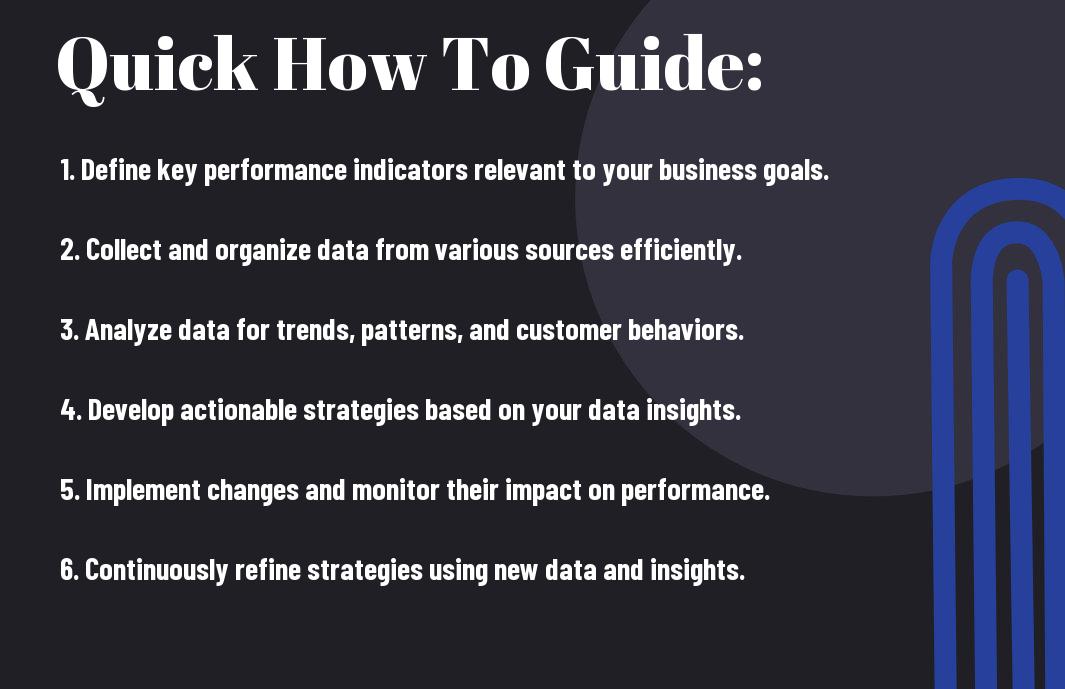
Most businesses today rely on data-driven insights to enhance their decision-making processes and drive growth. By leveraging analytics and customer insights, you can identify trends, understand your audience’s preferences, and optimize your strategies for better results. In this guide, you’ll discover practical steps on how to harness the power of data to elevate your business and create meaningful connections with your customers, ensuring sustainable growth in an increasingly competitive market.

Understanding Data-Driven Insights
The foundation of modern business strategies lies in understanding data-driven insights. These insights are derived from analyzing quantitative and qualitative data to inform your decisions and optimize your operations. By leveraging these insights, you can identify trends, understand customer behavior, and ultimately enhance your business growth.
What are Data-Driven Insights?
With data-driven insights, you harness the power of information to make informed business decisions. These insights come from analyzing patterns within your data, allowing you to understand what drives customer engagement, conversion rates, and overall performance. Essentially, they provide clarity in your business strategies by translating complex data into actionable recommendations.
Importance of Data-Driven Decision Making
Understanding the significance of data-driven decision making can enhance your competitiveness in the market. By relying on data rather than intuition alone, you base your strategies on empirical evidence, leading to better outcomes.
Insights derived from data ensure that your decisions are not only aligned with market trends but also tailored to your audience’s needs. In a world where consumer preferences shift rapidly, staying informed through analytics allows you to adapt effectively and seize new opportunities. This informed approach not only mitigates risks but also boosts your chances of making impactful strategic choices that promote sustainable growth.
How to Collect Relevant Data
It is crucial to gather data that aligns with your business objectives. Start by outlining your goals and determining what information can help you achieve them. Use surveys, web analytics, social media insights, and customer feedback to collect varied types of data. Ensure that your methods are both efficient and effective, allowing you to make informed decisions that drive growth.
Identifying Key Metrics
While it’s important to collect data, identifying the right metrics is even more vital. Focus on key performance indicators (KPIs) that reflect the health of your business, such as customer acquisition costs, conversion rates, and customer lifetime value. These metrics will allow you to track your progress and make adjustments as needed.
Tools and Techniques for Data Collection
While there are numerous tools available for data collection, it’s crucial to select those that best fit your needs. Consider platforms like Google Analytics for web traffic, SurveyMonkey for customer feedback, and social media analytics tools to gauge engagement. By utilizing a variety of resources, you can create a comprehensive data collection strategy that provides deeper insights into your business.
Plus, leveraging data visualization tools like Tableau or Power BI can help you interpret complex data sets. These platforms make it easier to identify trends and patterns in your data, enabling you to make strategic decisions quickly. Additionally, explore automation tools that streamline data collection processes, allowing you to focus more on analysis and less on gathering information.
Analyzing Data for Actionable Insights
Your ability to analyze data effectively is vital for translating raw information into actionable insights. This involves examining trends, patterns, and anomalies within your data, allowing you to make informed decisions that can drive business growth. By focusing on key metrics that align with your goals, you position yourself to harness the power of data-driven strategies.
Methods of Data Analysis
Now, there are various methods you can employ to analyze your data, including descriptive statistics, predictive analytics, and data visualization techniques. Descriptive statistics help summarize your data, while predictive analytics forecast future trends based on historical data. Data visualization tools, such as graphs and charts, make complex data more accessible, enabling you to draw conclusions at a glance.
Interpreting Data Results
With the data analyzed, the next step is to interpret the results. This involves understanding what the numbers mean for your business and identifying actionable strategies based on your findings. You should focus on the implications of the data, rather than just the data itself, to extract meaningful insights.
Data interpretation allows you to connect the dots between different findings, helping you identify underlying factors and causal relationships. For example, if you notice an increase in sales during a specific period, analyzing customer feedback might reveal important influences such as marketing campaigns or seasonal trends. By synthesizing these insights, you can make informed decisions that align with your strategic objectives, ultimately leading to enhanced performance and growth opportunities in your business.
Implementing Data Insights in Business Strategy
Not every business can seamlessly implement data insights into their strategy without proper planning. To effectively incorporate insights, you need a structured approach that allows you to integrate data-driven decision-making into your daily operations. Assessing your current processes and identifying gaps will empower you to develop actionable steps that align data with your overall business objectives.
Aligning Insights with Business Goals
There’s a significant advantage in aligning your data insights with your business goals. By ensuring that your data-driven initiatives support your strategic objectives, you create a strong foundation for effective decision-making. Start by clarifying your short and long-term goals and then map out which insights will help you achieve them.
Adapting Strategies Based on Findings
An effective data strategy requires adaptability. By carefully examining your findings, you can identify trends and make informed adjustments to your business operations. This flexibility allows you to respond to changing market conditions effectively and position your business for sustainable growth.
Based on your findings, consider integrating insights into your business model’s key components, like marketing tactics, resource allocation, and customer relations. Continually analyze customer feedback and performance metrics to refine your strategies. Regularly iterating your approach ensures that you respond to both market trends and internal performance, allowing you to stay ahead of the competition and better serve your customers.
Tips for Continuous Improvement
After implementing your data-driven strategies, it’s necessary to focus on continuous improvement to sustain growth and adapt to market changes. Here are some tips to keep your business evolving:
- Regularly analyze your data for new insights.
- Encourage team collaboration and brainstorming.
- Stay updated with industry trends and best practices.
- Implement small, incremental changes to test their impact.
Any step towards continuous improvement can yield significant benefits for your business.
Monitoring and Adjusting Strategies
If you closely monitor your key performance indicators (KPIs), you can quickly identify which strategies are effective and which ones need adjustment. Regular evaluations allow you to pivot promptly in response to data insights, ensuring that your efforts align with your business goals.
Leveraging Feedback Loops
Continuous improvement involves leveraging feedback loops to refine your processes and offerings. By encouraging feedback from customers, employees, and stakeholders, you gain valuable perspectives that can help enhance your service or product quality.
Feedback enables you to pinpoint areas of improvement and act on them swiftly. Use surveys, user reviews, and social media interactions to collect insights regularly. Incorporate this feedback into your decision-making processes, allowing you to create a more responsive business model. Engaging your audience in this way not only builds rapport but also fosters a culture of innovation and adaptability within your organization.
Factors Influencing Data-Driven Success
Now, to navigate the path toward data-driven success, several key factors play a significant role:
- Understanding your target audience
- Establishing clear objectives
- Investing in quality data
- Promoting collaboration among teams
- Ensuring ongoing training and support
Thou must pay attention to these elements to create a sustainable data-driven approach.
Company Culture and Data Literacy
On fostering a culture that embraces data literacy is vital for your team’s success. Encourage your employees to engage with data, ask questions, and develop analytical skills. This will empower them to make informed decisions and contribute to the overall growth of your business.
Technology and Infrastructure Considerations
Company-wide technology and infrastructure are foundational for effectively utilizing data. You should assess current systems and ensure they align with your data needs. This involves evaluating software, analytics tools, and data storage solutions that can scale as your business evolves.
Factors to consider include the integration capabilities of your technology stack and how easily it accommodates new data sources. You need to prioritize tools that facilitate data collection, analysis, and visualization while also ensuring that your infrastructure can support large volumes of data without compromising performance.
Final Words
Upon reflecting on how to use data-driven insights to grow your business, you must prioritize collecting, analyzing, and applying relevant data effectively. By understanding customer behaviors and market trends, you can make informed decisions that enhance your strategies and optimize your operations. Consistently reviewing your data will empower you to adapt to changes swiftly and innovate within your industry. Ultimately, leveraging these insights will not only increase your efficiency but also help you build stronger connections with your audience, driving sustainable growth for your business.
Leave a Reply